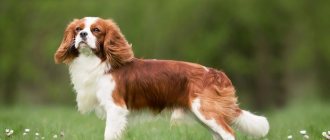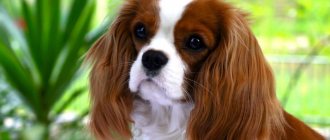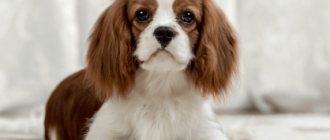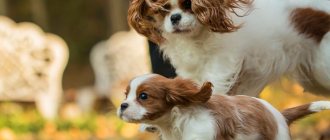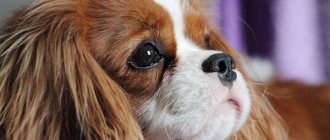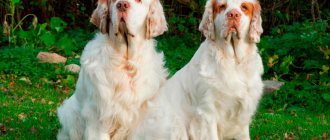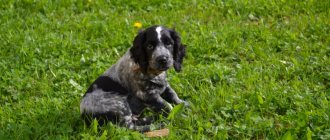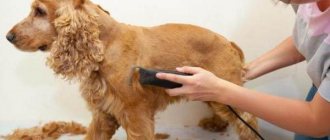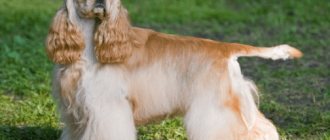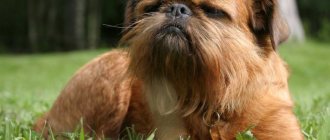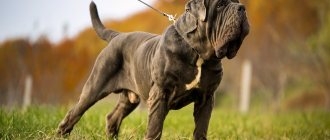Description of the Cavalier King Charles Spaniel breed
Popularity 217th place among 263 dog breeds
Lifespan:
11-12 years old
Breed group:
Decorative
Height:
up to 32 cm
Country of origin:
Great Britain
Average price:
15-30 thousand rubles
Weight:
from 5.5 to 8 kg
Latest articles Cat health
Ataxia in cats: what is it, how does it manifest and is treated 01/23/2022 180 0 0
Cat health
Leukemia, or viral leukemia in cats 01/23/2022 156 0 0
Key facts
The name of the breed is very long, but the breeders did not come up with other names, because spaniels have no use for it. The country of origin of friendly cavaliers (this is the abbreviated name of the breed) is Great Britain.
The characteristics of the Cavalier King Charles Spaniel breed say that these dogs are extroverts to the core. They have an irresistible desire to quickly get acquainted with the giant world around them, to smell and lick everything and everyone. Spaniels love to be stroked and gently brushed with a massage brush; In addition, they love to spend time with their owner, especially in his arms. A dog can achieve such intimacy in all ways known to him, most often through excessive affection. Cute nicknames will easily reflect the pet’s inner world; they will best match the description of the Cavalier King Charles Spaniel breed.
Small sizes allow you to keep gentlemen even in a small apartment. The height at the withers, that is, the height of the Cavalier King Charles Spaniel, reaches 32 cm (females are usually shorter than males). The standard weight is considered to be in the range from 5 to 8 kg (females weigh 5-6 kg, males - 6-8 kg). Non-compliance with the stated data is allowed, provided that the animal looks proportional, but a dog with miniature dimensions is more likely to win at the exhibition.
If your dog is active, eats enough and gets enough attention, this will have a positive effect on his condition. The average lifespan of a Cavalier King Charles Spaniel is 12 years; If the owners take good care of their four-legged friends, King Charles dogs live up to 15 years, which is considered quite a long time.
Character
Formidable watchman, ferocious hunter, observant bodyguard - these are epithets that describe working dogs, of which the Cavalier King Charles Spaniel is definitely not included. The nature of the dog in question is exclusively “domestic”, a little pampered and even vulnerable. He can be called a loyal friend to all family members, but as a guard or hunter he is ineffective.
Such a pet is a good companion. It’s a pleasure to spend time with him, anywhere: at home in an apartment, in the yard, outdoors or in a store. By the way, it is great for exhibition events. The dog is photogenic and artistic.
Finding herself the center of attention of a large group of people, she becomes excited and becomes more active, winning the attention of more and more spectators. So as a show dog, a representative of the breed is an excellent option.
She is unlikely to become a nanny for children, since she does not have a high level of responsibility, like, for example, a golden retriever. She will probably be offended if one of the kids gets too excited and hurts her. But, due to the natural lack of anger, he definitely won’t attack. He gets along well with middle-aged children, loves to play tag with them or run after the ball they throw.
There is often a sense of aristocracy in the behavior of this animal. It can be stubborn, especially if it was offended by something the day before. Many people associate this character trait of a dog with the difficulties associated with its training. This is partly true.
Since Charles King is characterized not only by pride, but also by laziness, he may simply not want to learn to follow commands. May growl or strike with teeth if very irritated. But such behavior is very rare for him.
If treated well and affectionately, the dog will be sweet, gentle and very friendly. Moreover, such a kind attitude on his part extends not only to the owners, but also to strangers. The dog is not at all aggressive, so he loves when strangers come into the house.
But excessive pride does not allow her to vigorously express positive emotions at the sight of guests. First, the dog will calmly approach the person who comes in, sniff him, and only then make a warm acquaintance if he doesn’t mind. This is a very calm creature that can not only run around the room playing, but also rest quietly in the middle of the day.
He loves when a person takes him in his arms. Can fall asleep on his feet. The dog is ready to fight for the owner’s attention around the clock. Trying to attract his gaze, he may even do mischief, for example, pull away the car keys or chew his shoes. He gets very upset if the owner is indifferent to him. Distressed by separation from their loved ones, Cavalier Kings even refuse to eat.
History of the origin of the Cavalier King Charles Spaniel
The breed's ancestors, brave miniature hunters, accompanied the Celtic people starting in the ninth century. For a long time they traveled side by side with people, but, once in England, they settled on the territory of this country. Court people, in particular the Stuart dynasty, left gentlemen at court - they played the role of decorative dogs, which they treated tenderly and reverently because of their great love for them. It was believed that the Cavalier King Charles Spaniel breed was developed by Charles II, but the monarch only encouraged breeding work. Despite this, the breed received his name.
John Churchill, Winston Churchill's ancestor, was also fond of breeding spaniels. For his great services to his homeland, the man received an estate where he could breed dogs. In addition to standard breeding, Churchill tried to introduce diversity into the breed's gene pool. The breeder managed to do this: thanks to his activities, the following types of colors appeared: Blenheim and white-pink.
The fashion for pugs, which arose in the eighteenth century, spread to Cavalier Spaniels and made them a purely decorative breed - all the working qualities of the dogs were dulled. Despite this, they remained popular among the nobility, because they proved to people that they remain faithful to their owner in any situation: during palace coups, the dogs did not abandon their owner, helping him to the end.
History of the origin of the breed
All varieties of spaniels have been popular since ancient times as hunting dogs. Dwarf or toy spaniels became famous around the 9th-11th centuries. They were kept in castles and palaces of dukes and even kings. At first they were used for hunting, but gradually they turned into decorative pets. Images of these dogs can be found in the paintings of many famous artists.
Since the time of Charles II, the words king (king) and Charles (the name Karl is written in English as Charles) have appeared in the name of the breed. These dogs enjoyed privileges like royalty and were even allowed into parliament. Noble ladies carried these small fluffy dogs in their arms. They kept them warm and served to attract insects, which were common in voluminous hairstyles at that time.
During the reign of William III, the popularity of spaniels began to decline. This king liked pugs and other short-faced dogs. To please him, breeders began crossing King Charles Spaniels with Japanese Chins and Pugs. As a result of this selection, the appearance of the breed's representatives has changed greatly.
At the beginning of the 20th century, enthusiasts began to revive the King Charles Spaniel. They bred dogs with traditional appearance. To avoid confusion, the revived breed was called the Cavalier King Charles Spaniel. The word “Cavalier” was added because this was the name given to supporters of King Charles, during whose reign the breed was especially popular.
The Fédération Cynologique Internationale officially recognized this breed in 1955. These dogs began to spread throughout the world. In Russia they have been known since the beginning of the 20th century, but they became popular only in the 80s.
Similar dog breeds
Pomeranian Spitz
Shih Tzu
Yorkshire Terrier
Bichon Frize
Appearance of a Cavalier King Charles Spaniel
Videos can show how beautifully the coat shimmers in the morning sun, and pictures and photos of the Cavalier King Charles Spaniel prove that this is a smart and mischievous pet.
General impression
The main thing in assessing the appearance of a Cavalier King Charles Spaniel at an exhibition is the proportionality of the height at the withers and weight, but judges can also pay attention to the compliance of the indicators with the standard. A dog may not be allowed to be bred if it does not meet certain criteria.
Head
The head is quite voluminous, the skull is not convex. The high-set ears are covered with dense hair. The stop is normally expressed. The eyes are round and set wide apart; Characteristic colors range from a mixture of brown and gold to black. The look is conscious and friendly.
The muzzle is cone-shaped, narrowing from the base to a black nose with well-developed nostrils. The developed upper lip covers the lower lip. Scissor bite.
Neck
The neck is of normal length with a slightly convex nape allowing the dog to hold its head proudly.
Torso
The somewhat stretched body has smooth, rounded shapes. The shallow chest is oval, connected by a short loin with a flat back, smoothly sloping croup.
Forelegs
Strength, proportionality of length to the body, parallelism are characteristic of the front paws. The elbow fits tightly to the chest. The rounded metatarsals gather into a ball. Claws and pads are black.
Hind limbs
Standing and looking from behind, you will notice that the spaniel's slender hind legs are parallel, not sloping, and more muscular than the front legs. The knee joint is not everted. The hock joint is normally expressed. The paws are rounded and gather into a ball. Claws and pads are black.
Tail
The tail is not docked, which is why it retains its natural length. It doesn’t matter what emotions the pet is experiencing: the tail is almost always no higher than the line of the back.
Movement
The energy and cheerfulness inherent in the “boys” and “girls” of this breed is noticeable in the animal’s fast, springy gait. The paws are moved parallel to each other.
Wool
The wool is smooth and silky. The hairs are either straight or somewhat wavy.
Color
What colors are typical for the Cavalier King Charles Spaniel?
- Blenheim - rich chestnut color of spots on milky white wool, the crown is “marked” with a white diamond;
- ruby - a rich ruby shade of wool, white spots on which are considered a defect;
- black and tan - blue-black coat with red tan marks above the eyes, on the cheekbones, inside the ears, body, tail;
- tricolor - the “background” of pearly white color is diluted with red and black spots.
Solid colors should not be disturbed by spots, inclusions and impurities of any color.
Size
The Cavalier King Charles Spaniel is quite small in size. The normal weight of a Cavalier King Charles Spaniel varies from 5.4 to 8.2 kg, height - up to 34 cm. Puppies quickly gain weight, because of this it is important to monitor their diet. An adult dog must meet the standard to participate in exhibitions, because often obese animals are not allowed to participate.
Types of purchase
Cavalier King Charles Spaniels come in different colors. You can buy a dog:
- Black with bright tan marks.
- Ruby color.
- Redhead.
- Tricolor (combination of black, tan and piebald).
- Blenheim (there are chestnut spots against the background of the white-pearl shade of the coat).
Puppies are sold by age:
- Two months old.
- 2.5-3 months.
- Four months old.
- 5 month old.
- Six months old.
Depending on the degree of purebredness, you can adopt a dog:
- Show class (the animal fully meets the standards and can take prizes at exhibitions).
- Pet class (there are significant deviations in appearance from the accepted standard, the dog is suitable only as a pet).
- Breeding class (there are minor deviations from the standard, the animal is allowed to be used for breeding).
At point of sale:
- According to an ad on the Internet or in a newspaper.
- From a professional breeder.
- At the pet market.
- In a specialized nursery.
Personality of the Cavalier King Charles Spaniel
Who is the Cavalier King suitable for? The uniqueness of the breed lies in the fact that its representatives feel good in the company of active youth, young families, and retirees. The main thing for charming fluffies is the opportunity to be close to the owner: the dog needs mandatory tactile contact, and without an emotional connection the baby will quickly disappear. Therefore, it is important for those people who have adopted a spaniel to be aware of all the responsibilities they have regarding the psychological comfort of their four-legged friend.
Other well-known facts are the positive character traits of the Cavalier King Charles Spaniel: openness, friendliness, energy, sanguine temperament. The gentleman will play with children (especially snowball fights outside in winter), will easily share the territory entrusted to him (but not the owner with other animals), and will not hesitate to ask a stranger on the street to scratch behind the ear.
Sometimes this behavior can irritate the owner, but the only thing that can be done is to play with the pet so that it releases all its irrepressible energy. Because of this, dog experts advise either active people or large families to own dogs of this breed. The third “option” could be buying another four-legged friend.
At home, the gentleman will get bored very quickly (it doesn’t matter whether the owner lives in an apartment or in a country house). Therefore, a long walk is required. Puppies are much more restless than adults, so some corner should be created for them where they could splash out energy and explore the world around them.
How to choose a nursery
The first thing you should pay attention to when choosing a nursery is the presence of a sanitary order. If puppies are kept in mud from birth, then what kind of health can we talk about in the future? If, when asked to send a photo of a puppy, the buyer sees that his eyes are running and his fur is dirty or tangled - it is better to refrain from purchasing. Discussing Cavalier King Charles Spaniel puppies on the forums will allow you to choose the best ones. There, the future owner will be able to find out good and bad reviews about breeders from real people, and choose those closest to him, where they offer the best representatives of the breed. There you can often see an advertisement for sale and contact real people, not scammers.
When visiting, it is worth inspecting the place where the puppies are kept. Many so-called breeders keep puppies in a regular barn, which is why they acquire serious illnesses, including kennel cough.
Among all the proposals, special attention should be paid to:
- the presence of a pedigree;
- certificates of genetic tests performed by parents;
- drawing up a contract for the sale and purchase of an animal;
- the age of the puppies offered and the availability of vaccinations (collection from the 45th day, when three vaccinations according to age are given, about which there are marks and vaccine stickers in the veterinary passport; in the absence of the third vaccination, the breeder is obliged to warn and hold the owners responsible for it, which is stated in the contract) .
You should not buy a puppy cheaper, but without documents - instead of a Cavalier King Charles Spaniel, they may well sell a crossbreed, or another similar breed - a King Charles Spaniel.
Education and training
Raising and training a Cavalier King Charles Spaniel is more reminiscent of a fun game, without which even the simplest exercises will not be accepted by the baby. It is important for well-mannered and shy gentlemen to feel the excitement, to find out that for the performed trick, a “reward” awaits him - a dog treat.
How to raise a King Charles? The foundations are laid in the nursery, where the social adaptation of puppies occurs. Training should begin when the puppy is two or three months old. The baby’s very first skills are the ability to respond to a nickname, knowledge of the commands “Sit!”, “Lie down!”, “Stand!” When the first stage is completed, you can move on to working on behavior outside (in autumn, spring, winter you need to pay attention to hygiene after training, and in the summer - a thorough inspection for the presence of ticks). A six-month-old puppy should know the commands “Near!”, “Calm down!” and some others that will help the owner restrain the playful nature of the pet.
Training should take place in a relaxed, friendly atmosphere. Their time can be increased in proportion to the puppy’s age, which will allow achieving good results.
Is it okay to use brute force or yell at the animal? Under no circumstances should one resort to violence, since the spaniel sees the owner as a reliable support, and not a tyrant; a different state of affairs can shake the dog’s delicate psyche.
Separately, the questions “How to wean” and “How to accustom” a puppy to something are highlighted (owners especially often complain that the pet begins to chew furniture). You can easily instill good manners in a trained animal - just constantly unobtrusively remind him how to act in a given situation. It is important to teach your baby to go to the toilet every day - many Cavalier Kings do not like to take care of their appearance.
Cavalier King Charles Spaniel Health and Diseases
The small number of dogs of this breed in the British Isles and the desire of the British to preserve the purebred of the breed led to closely related relationships between the animals. The mixing of the blood of “relatives” led to serious health problems for their descendants - gentlemen are characterized by a high mortality rate from hereditary diseases. Some of them can be noticed when choosing a puppy in a kennel, others appear throughout life.
Possible diseases
Acquired diseases in dogs of this breed can be prevented by timely medical examinations and vaccinations. Infections of the eyes and ears, and dental diseases are eliminated by daily toileting. It is important to monitor the condition of the coat so that the dog does not become a carrier of skin parasites (to do this, you need to look at the space on the face near the nose, on the back, in the groin area, under the tail).
Cavaliers are characterized by the frequent development of allergies, especially to food due to weakness and mild “irritability” of the digestive system. In addition to food, the cause can be flowering, bites of certain insects. Diseases of the endocrine system in representatives of this breed are not uncommon: for example, diabetes mellitus or obesity (may be associated with improper diet, lack of physical activity).
It is necessary to monitor the condition of your pet; at the slightest manifestation of excessive lethargy, detachment, or drowsiness, contact a veterinarian for further examination. If the disease was noticed at an early stage, it can be corrected without harm to the dog’s health.
Hereditary diseases affect both the vital functions of the body and external data. Common diseases:
- episodic falling syndrome;
- curly coat syndrome;
- dry eye syndrome;
- myxomatous valve degeneration is a heart disease that can cause heart failure;
- retinal dysplasia;
- patellar instability - the kneecap is displaced in relation to the hip bones and joints;
- Syringomyelia is a chronic disease of the central nervous system.
Mostly hereditary diseases are associated with the cardiovascular or musculoskeletal systems. Diseases that affect the appearance can cause an animal not to be admitted to breeding.
Reproductive health
Some owners think about offspring when a little bitch comes into heat for the first time, which is fundamentally wrong, because the animal’s body may still not be formed. In order not to spend money on expensive treatment, mating and subsequent pregnancy, it is better to plan for the second or third heat.
During pregnancy and before giving birth, the Charles King needs to be provided with the most comfortable conditions: absence of stress, proper balanced nutrition, good living conditions will have a positive effect on the health of the female and future puppies.
After the birth of the babies, you need to worry about what to feed the dogs, which specialist to contact to monitor the health of the Cavalier King Charles Spaniel and its offspring, and how to complete all the necessary documents. If the owner is not ready to resolve issues of this nature, the best solution would be to sterilize the dog.
Home → Useful tips → Education → Toys for dogs
Dog toys
Dog toys
In any pet store you can find a huge number of toys for every taste and budget. The choice is so large that sometimes you just get lost and don’t know which one to buy.
Take this purchase seriously, as a toy is not just entertainment for a young dog, but a way to learn about the outside world. In many hours of play, the puppy prepares for adult life, learns to defend its territory and “hunt.”
Why do you need a toy?
1. Toys help your dog cope with boredom and loneliness while you are away from home.
2. Active games help dogs release pent-up energy and keep themselves in good physical shape.
3. A properly selected toy will help you keep your shoes and furniture safe and sound.
4. Toys for dogs are used in training, for example, to perform the “Fetch!” command.
5. A fun game is a great way to establish a warm relationship with your puppy and help him adapt to a new place.
When choosing a toy for your puppy, first of all pay attention to its safety.
Buy only specialized toys for animals!
Soft toys for children may contain foam, plastic and simply small parts that, if ingested by your dog, can injure its esophagus or cause poisoning. Therefore, if you have children, try not to let your puppy play with their toys.
It is not advisable to buy soft toys for animals, as they tear quickly, and the filling they contain can harm the health of the pet. If you purchased such a toy, then your pet should play under your control!
It is better if the dog has several toys. But you don’t need to overwhelm her with all the new products at once - alternate them so that the animal does not lose interest.
The most important thing is the size. The toy must fit into the animal's mouth, so of course toys for large and toy breeds will be completely different
Toys must be made from safe, non-toxic materials that do not have an unpleasant specific odor. It is best to purchase toys made of latex or vinyl.
Check their integrity regularly: if you
If you find that your puppy's toy is damaged, be sure to replace it. Under no circumstances should your dog be allowed to swallow chewed off parts - this can lead to gastrointestinal problems.
Consider your dog's preferences and temperament
All puppies and dogs have different temperaments, so try to take into account your dog's personality.
An active dog will be delighted with a frisbee, a ball and a puller, while a little introvert will prefer toys for solo play so that he can lie down in a corner and chew on the little thing.
Does your dog spend endless time near the refrigerator, trying to get something tasty out from under it? Treat her with Kong toys that include a piece of treat or food.
Has your dog chewed on more than one pair of shoes and eaten a table leg? Don't scold her too harshly, but rather buy durable rubber toys that she can chew on.
6. Perhaps your dog is very energetic and will never refuse a fun game? Opt for balls, frisbees or pullers; this will make your games with your dog truly active.
7. For walks, you can purchase flying toys and fetch items. Many dogs get excited about running after various objects, love to find them and bring them to their owner. Fetch toys are easy to hold in the mouth and are great for training.
8. If you just brought a small puppy into your home and don’t know what his temperament is, buy him 5-6 toys of different types to understand which ones he will like best.
9. For pets whose bite has already formed, you can purchase special tug toys that are made of high-strength materials and perfectly train the animal’s grip. But such objects should not be left within the reach of the dog without supervision, as he can fray them, render them unusable and eat parts that he can tear off from them.
10. The most favorite toy is the puller. Durable, withstands the jaws of dogs from toy to husky)
It is very convenient in the sense that you can quickly “run out” the dog.
Pullers are projectile toys whose purpose is to exhaust your dog and give him high-quality physical and mental exercise. There are two of them in the set, you need to read how to play dog-puller correctly, you can quickly teach your dog. Fun for the owner and the four-legged)
In order for the animal to be happy and not get bored during the absence of its owners, it must have a sufficient number of toys at home that it can freely get whenever it wants. When buying several toys at once, you should not give your dog everything at once; it is better to do this a few days in advance, and then he will not quickly lose interest in these items.
Features of feeding and diet
Cavalier Spaniel nutrition is an important component of the health of a dog of this breed. Dogs are prone to rapid weight gain, gastrointestinal diseases, and allergic reactions to food. If obesity can be “cured” by adding a little more exercise to your pet’s life, then health problems cannot be ruled out. Therefore, for every owner of a four-legged friend, the questions are “what to feed?”, “how to feed?”, “how much to feed?”, “what food to choose?” often become vital.
Feeding a spaniel can contain either natural products or dry food. Is it possible to feed an animal both food and food? Mixing the two types of diets can lead to digestive problems and is therefore strictly not recommended.
Natural nutrition requires the owner to be aware of the pet’s energy needs, the norms for the content of proteins, fats, and carbohydrates in products. Owners who choose this type of nutrition often buy feeding guides for a puppy or an adult dog in order to rely on the diet given in the publication. In addition, the book contains a list of foods allowed for consumption:
- lean red meat (beef);
- poultry meat (turkey);
- rabbit meat;
- low-fat varieties of sea fish;
- offal;
- whole grains (oats, brown rice);
- vegetables (preferably fresh to preserve fiber);
- fruits (except for citrus fruits, pomegranates, overly sweet fruits);
- fermented milk products (low-fat cottage cheese, yogurt, yogurt, kefir);
- vegetable oils.
It is important to monitor the body’s reaction to a particular product and try to eliminate allergy-causing irritants. As a treat, you can give low-fat cheeses and quail eggs. Spicy foods, processed meat products, and baked goods are strictly prohibited.
What food should I feed my dog? After weaning from the bitch, the puppy is switched to food, which he should receive for the first months of his life. After this, the owner can choose another premium food for the four-legged dog, appropriate for its age and health status.
How many times should you feed your pet? The answer to this question depends on the age of the spaniel. A one-month-old puppy receives six meals a day. At the age of five months, the baby is transferred to three meals a day. An adult dog eats twice a day. In all cases, the daily portion of food is divided into the number of meals.
Care and maintenance
Caring for and maintaining a King Spaniel involves some changes in the home. The bones of small breed dogs are quite fragile, so it is important to adapt high surfaces for joint leisure (for example, placing a low stand on the sofa). Slippery parquet can affect the curvature of the paws, which is especially undesirable for exhibition animals; you can replace the flooring or add a little coziness to the interior with carpets.
Drafts are also bad for the health of your four-legged companion, so it is important to choose a good location for your pet's bed. A medium-sized soft bed and rubber toys should be placed in a warm but well-ventilated room. Fresh water and food should be freely available.
As for caring for a long-haired dog of this breed, it is quite simple to perform. Regardless of the class of the animal, it must be taken to the groomer. Grooming is a set of services for caring for the appearance of a spaniel, including washing, trimming hair and claws, cleaning eyes and ears, brushing teeth (oral care is important to prevent tartar). All these procedures can be carried out at home.
Rubbing the eyes and examining the ears should be made a daily ritual - such a toilet will save the owner from wasting money on visiting veterinarians. Claw trimming is mandatory during the period of time when the animal is not able to grind its claws off on the asphalt on its own (this means the autumn-winter period).
How to care for your cavalier during shedding? If in normal times the coat requires brushing only once a week, then the shedding period means daily brushing. Loose fur can be removed with a vacuum cleaner.
Tips for choosing a puppy
How to choose a Cavalier King? Buying a healthy Cavalier King Charles Spaniel puppy requires the same principles as when choosing any other dog.
First you need to find a proven nursery where all the necessary conditions have been created for the kids. There are good nurseries in Moscow, St. Petersburg, Tula, Vyazma, Novosibirsk, Izhevsk and some other cities. Then, get to know the spaniel’s parents to make sure they have no defects. Only after this can you begin to choose a four-legged friend.
The puppy must be active and curious; the interest shown towards the future owner is a good sign. Lethargy, aggressiveness or excessive cowardice are not allowed - the standard of this breed prescribes a friendly character.
Physical health, just like mental health, can be monitored. A small dog should not limp or whine while walking; the softness and silkiness of the coat cannot be disturbed even by small bald patches. The skin should be a pleasant pinkish-peach hue, the mucous membranes should be red-pink.
If the future owner is not confident in his competence, he can take advantage of the breeder’s consultation (the cost is often included in the price of the puppy). Thus, it is important to pay attention to even minor details - the chance of acquiring a faithful, healthy comrade who is interested in living together increases significantly.
Appearance: what you should pay attention to
When choosing a puppy from nurseries, you should carefully examine the animal. It should not have visible coat features (bald spots, short-haired areas), dermatitis, rashes, rough or matted hair. It is necessary to pay attention to the ears and eyes - these are problem areas for dogs. The ears should be pink, free of accumulations of dirt and dust, and free of unpleasant odor. The eyes are not leaking, the fur in the corners is not dark in color, which may indicate lacrimation and disease.
At two months old, Cavalier King Charles puppies must meet the following description:
- the forehead is straight, sloping, like the cheekbones. Head with soft outlines. The distance between the ears is almost flat;
- It is worth paying attention to the animal’s nostrils. If they are small and pink - a deviation from the norm, refuse to buy a puppy. Ideally, they are well developed, medium in size, dark in color;
- the eyes are not bulging, puppies can easily be confused with another breed, so you need to pay special attention to them: they should be widely spaced, large, not watery, and without redness;
- Before purchasing, you need to study possible bite options. Only scissor-shaped is acceptable for the breed;
- the neck has a slight deflection, almost imperceptible. The length is not too long;
- the muscles are well developed, toned, palpable;
- If you run your fingers along the back, the vertebrae should be of moderate length, the intervertebral discs should be thick.
There are also several tips that you should rely on when choosing an animal.
Cavalier King Charles Spaniel, how to choose a puppy by color and standards
In particular, you need to pay attention to the description of the color; in the breed standards, only four main types are allowed:
- Blenheim (white background with brown spots);
- black and tan;
- ruby (red with a very bright tint, almost chestnut);
- tricolor (black background with spots of red and white on the face, ears, under the tail).
The weight of a puppy at the age of 3 months should reach 3-4 kg. Many people are looking for a smaller puppy, so that the adult weight is less than 6 kg. Such puppies are immediately discarded from breeding, will not take prizes at exhibitions, and can only be used as a companion and sofa friend.
What else to consider when choosing a puppy
There are several important nuances that will help you buy a healthy and strong representative of the breed that fully corresponds to the declared breed qualities:
- lack of aggression and anger - the puppy should be inquisitive, active and friendly;
- in the nursery you can request documents confirming that the dog’s parents have undergone genetic tests for the absence of defects, this will help reduce the risk of diseases in puppies;
- you definitely need to get acquainted with the pedigree (if there is none, but the breeders claim that these are beautiful and good parents, inbreeding between relatives is possible, which entails deviations in the psyche and development of the animal);
- the puppy must actively respond to games and be inquisitive; if he is lethargic, this may indicate mental and physical exhaustion.
It is important to remember that the veterinary passport is not proof that the King Charles Spaniel puppies correspond to the breed - only a pedigree can confirm this. Many breeders try to show buyers a veterinary vaccination passport to tell them that these are the documents for the animal.
